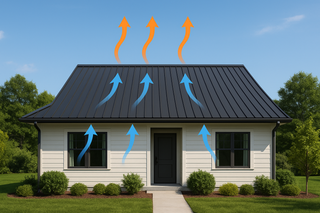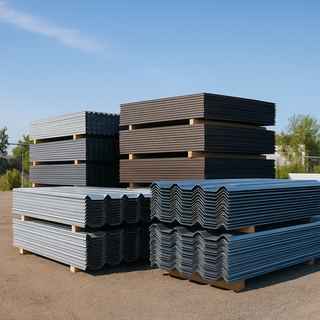When it comes to metal roofing performance, few things are as misunderstood — or as critical — as attic ventilation.
Most homeowners and even some contractors wrongly assume that metal roofing eliminates the need for attic ventilation. Others install a high-end roof system but neglect air flow, leading to moisture buildup, ice dams, and premature failure.
In this comprehensive guide from Top Tier Metals, we break down everything you need to know about how ventilation works, how to get it right under a metal roof, and why proper airflow protects your entire home — from energy bills to structural integrity.
1. Why Attic Ventilation Matters Under Metal Roofing
Whether you're installing standing seam, R-panel, or corrugated panels, your attic still needs a properly designed ventilation system.
The Three Core Functions of Ventilation:
-
Temperature Regulation
-
Keeps attic temps closer to outside air
-
Reduces cooling loads in summer
-
-
Moisture Control
-
Prevents condensation under roof deck
-
Reduces risk of mold, mildew, and rot
-
-
Roof System Longevity
-
Minimizes thermal stress on fasteners and panels
-
Prevents premature deterioration of decking and insulation
-
2. The Two Types of Ventilation Your Attic Needs
A balanced system uses both:
A. Intake Ventilation (Low Point)
-
Draws in cool, dry air from outside
-
Installed at soffits or eaves
-
Keeps air circulating upward
B. Exhaust Ventilation (High Point)
-
Releases hot, moist air from attic
-
Installed at ridge, gable ends, or with roof vents
-
Creates natural convective airflow
The ideal ratio:
1:1 intake to exhaust, delivering 1 square foot of net free vent area per 300 square feet of attic space (or per 150 if no vapor barrier is used).
3. Common Myths About Metal Roof Ventilation
MYTH 1: Metal roofs don’t need attic ventilation.
FALSE. The need for ventilation is about your attic, not your roofing material. Metal roofing panels don’t “breathe.” Ventilation is still critical underneath.
MYTH 2: Exposed fastener panels ventilate through gaps.
FALSE. Gaps mean leaks. Proper venting requires purpose-built intake and exhaust points.
MYTH 3: Ridge vents don’t work with metal roofs.
FALSE. Ridge vents work extremely well with metal — as long as they’re compatible with your profile and sealed correctly.
4. Ventilation for Different Metal Roof Types
A. Standing Seam Systems
✅ Best ventilation method:
-
Continuous ridge vent at the peak
-
Soffit vents for intake along the eaves
-
Optional gable vents for additional air movement
Top Tier Tip: Use a profile-specific vent system that integrates with the standing seam panel height and pitch.
B. Exposed Fastener Systems (e.g., R-panel, corrugated)
✅ Ventilation method:
-
Metal ridge cap with mesh vent material (high-density polyethylene preferred)
-
Soffit intake or gable intake
Top Tier Tip: Ensure ridge cap allows airflow while still preventing rain and snow intrusion — avoid generic hardware store products.
5. Understanding Ridge Vent Systems for Metal Roofing
How it works:
-
A 1" to 2" gap is cut along the roof ridge (after decking is installed)
-
Vent material is placed over the gap (baffle/mesh)
-
Ridge cap is installed over the vent system
Choosing the right system:
-
Must match your panel profile height and roof pitch
-
Must be UV-stable, water-resistant, and animal-proof
-
Popular products: ProfileVent, Ventco, Quarrix
Improper ridge vents cause:
-
Leaks in wind-driven rain
-
Poor airflow due to undersizing
-
Early paint failure from internal moisture
6. What Happens Without Ventilation?
Ventilation issues don't always show up immediately — but over time, they can cost thousands in hidden damage:
| Problem | Caused By | Symptoms |
|---|---|---|
| Condensation buildup | Inadequate exhaust | Water spots on sheathing, drips, mold |
| Decking rot | Trapped vapor from insulation or living space | Sagging roof, mildew odor |
| Ice dams | Uneven attic temps | Icicles, roof leaks after freeze/thaw |
| High energy bills | Overheated attic in summer | HVAC overuse, short system life |
| Rust/corrosion on panel underside | Unvented, humid air pockets | Paint bubbling, structural weakening |
7. Best Ventilation Strategies by Climate
| Climate Zone | Recommended Setup |
|---|---|
| Cold/High Snow | Ridge vent + wide soffits + air baffles above insulation |
| Humid South | Ridge vent + gable vents + vapor barrier under insulation |
| Dry/Hot | Ridge vent + turbine or solar exhaust fans for active draw |
| Coastal | Ridge vent with marine-grade mesh; wind baffles under soffit |
| High Wind | Low-profile ridge vent + internal baffling to prevent wind-driven rain |
8. Special Considerations for Retrofit Roofs
If you're installing a metal roof over existing shingles, you must still maintain vent pathways.
Key Retrofit Practices:
-
Install vented closure strips at ridge
-
Use furring strips or battens to create air channel above old roof
-
Ensure soffits are open or perforated (not blocked with paint or insulation)
Top Tier Tip: Ask us about breathable synthetic underlayments that reduce condensation risk in retrofit installations.
9. Troubleshooting & Inspection Guide
| Issue | Check This First |
|---|---|
| Musty attic smell | Blocked soffit vents, no ridge exhaust |
| Ice buildup at eaves | Insufficient intake or thermal bridging |
| Attic over 120°F in summer | No ridge or gable vents, inadequate air exchange |
| Drips from panel underside | Warm moist air condensing on cool metal |
| Interior mold/mildew on ceiling | Poor attic vapor control or inadequate airflow |
Quick fix: Use smoke pencil or incense stick near vents to visualize airflow direction and verify it's moving upward.
10. Final Thoughts: Ventilation Makes or Breaks the System
A premium metal roof is only as good as the air beneath it. Proper attic ventilation:
-
Protects your roof, attic, and home structure
-
Optimizes energy efficiency
-
Keeps warranties valid
-
Reduces maintenance and increases comfort
At Top Tier Metals, we don’t just supply roofing panels — we guide you through the full system to ensure your install works for the long haul. Whether you’re planning new construction, a retrofit, or troubleshooting an existing roof, we’re here to help.
Need Help Choosing the Right Ventilation Setup?
Our experts can walk you through panel-compatible ridge vent kits, breathable underlayment, and climate-specific airflow design.
Let’s get your roof breathing right — and lasting longer.






